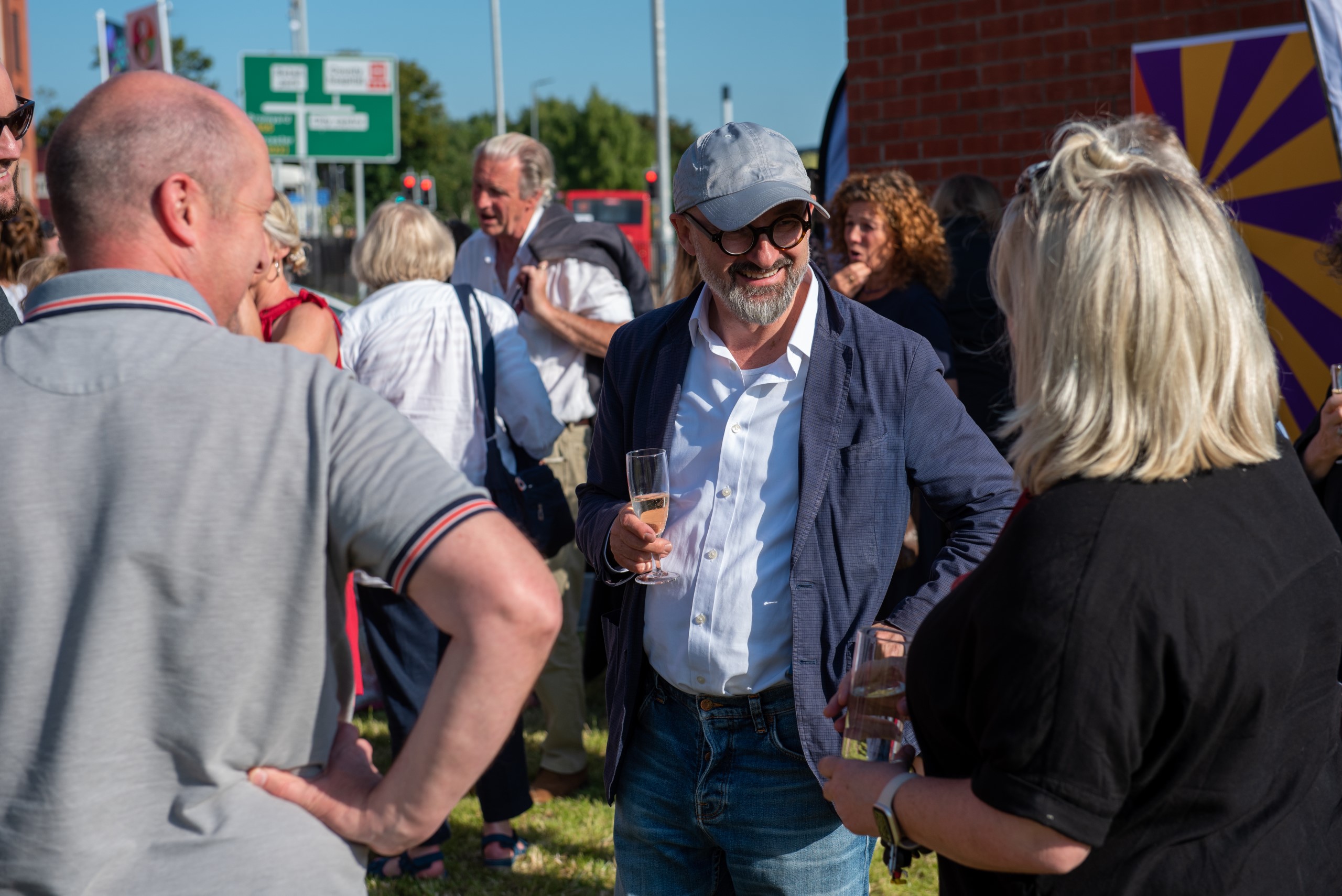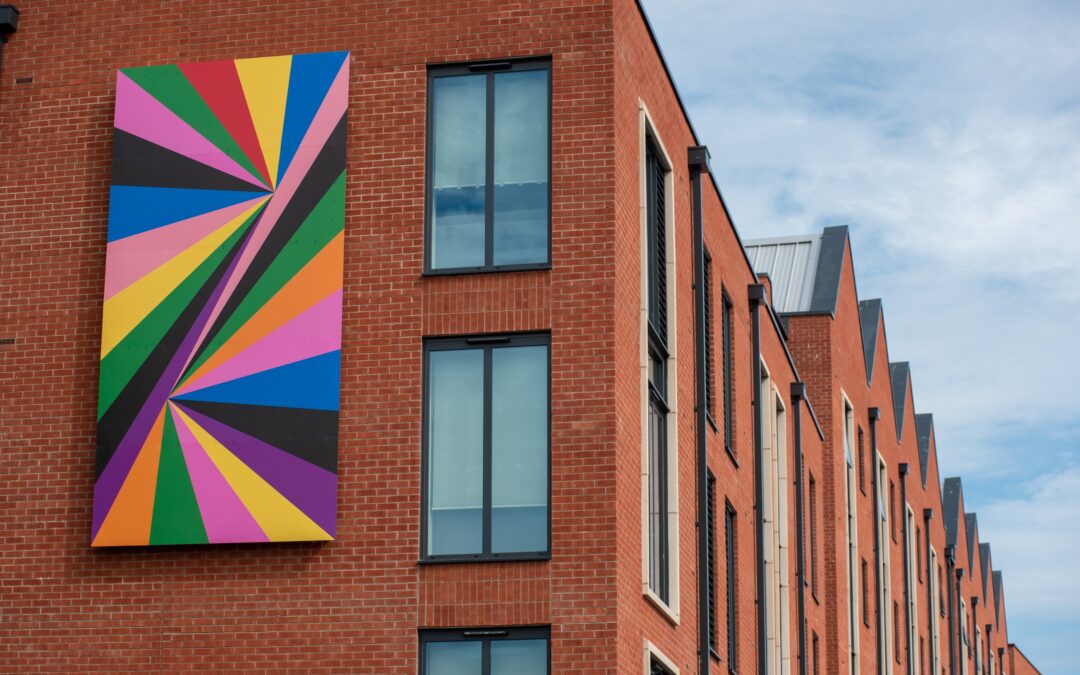An interview with the designer of the No. 1 Station Approach installation
If you visit Hereford between now and April 2023, you’ll see some very colourful artworks next to the railway station. The artworks mark the start of a new cultural gateway to Hereford, welcoming visitors and enriching residents’ experience of the city. The No. 1 Station Approach installation is one of our fourteen projects that have been made possible thanks to our successful £22.4million funding bid.
No.1 Station Approach is Hereford College of Arts (HCA) and NMiTE’s new student accommodation. It features two vibrant geometric artworks on each side of the building, as well as a number of dazzling flags by artist Lothar Götz. The project is a partnership between Meadow Arts and HCA.
Annabel of Meadow Arts recently chatted to Lothar about his work and how he hopes the artworks are perceived in Hereford.
How did you go about designing your work for the space at Station Approach?
[On the building itself] there are two prepared places for artworks which were probably part of the planning permission. The architects were planning for artworks on the two gable ends. It was like responding to these restrictions. I had a similar approach to Towner. The location is in one of these typical nondescript areas you [see] when you arrive in a city. You come out of the station, there are mainly cars and most people probably think [about] how they can get quickly into the town centre. I wanted to make an eye-catching artwork.
What inspires you to create your unique, strong, beautiful artworks?
It’s quite a lot of things. In previous interviews I’ve talked a lot about architecture. I’m also inspired by wall paintings, lots of things that are often from my childhood. As a young student the Bauhaus was very important as well as the wider Modernist movement and their use of colour. Two artists who were important [were] Ellsworth Kelly and Carmen Herrera. Then I get inspired by lots of things from daily life. I’m always excited when flowers come out. I do believe that nature is fantastic. I don’t paint a landscape, but I think the way of looking at a landscape does inform my work.
I’ve lived in London now for more than 20 years. I really do love big cities because I love going around in the evening and seeing all the lights. I’ve always been obsessed with Piccadilly Circus because of the adverts and the buzzing of lights. I’m not doing it very often any longer, [but] I really enjoyed going clubbing for many years, and I do really like the lights in discos or in clubs. I’m a big fan of disco balls and all their glimmering light.
You’ve produced pencil sketches of the pieces for Hereford. You’ve said in past interviews that you love the openness of drawing and the fact that it’s not perfect. I felt that was unusual as the finished products are so geometric. How does physically drawing help the creative process?
Nowadays many people think, particularly in my case, that I sit in my studio at a computer and draw digitally, scan the building or the site in, and then it’s done. That’s not the way I work. I usually do a site visit, take photos. Then I might print them out and work in a very conventional way. I start drawing up ideas. It’s a physical experience encountering a site. There is a phase where I’m just testing out colours and ideas and then I often use a photo, tracing paper and make sketches on top of that. Lots of people, architects and designers are still doing that. It’s a phase that is a bit hidden nowadays because in a presentation it’s so often expected that everything is super slick and then everything kind of looks more perfect than in reality. That is exactly what I don’t like. I sometimes see images of mockups that are so perfect that I think what is the point? The final result can hardly top the aesthetic of the design model and it takes away the excitement the real thing.
One of the reasons why I like conventional drawing is that I think it’s an extremely open medium. It’s not about perfection. I think if you [draw] immediately on the computer it hides mistakes. I need the time it takes me to fill in a colour to work out the design. What I love about drawing is that it’s so accessible. It takes very little energy and it’s environmentally friendly! If you think about how much energy you use if you’re constantly on a computer… Everyone on a computer is also using a programme, so you’re basically a user of an Apple programme or a Microsoft programme. There is something in me that rejects that. I love pencils and I love paper.

Do you have a stand-out memory from childhood when you realised that you wanted to be an artist? I’ve noticed you’ve recently shared on Instagram some childhood drawings of you extending your childhood home.
Probably not one stand-out [memory]. It was pretty clear to me from a very young age that I wanted to do something art related. I didn’t grow up in a really arty family [but] parents were interested in art. I think there were lots of little moments when I realised the things I was interested in were art related. I was also very interested in architecture. I grew up in a small market town, a bit like Hereford. There was a time when there was lots of building work. I was obsessed with the building sites. We grew up in a very modest, small, detached house. I had all these ideas of extending it.
I hardly played with boys of my age. Playing with girls, which I did more, was seen by neighbours with a bit of a funny eye. They didn’t like it that much. So I escaped into a kind of fantasy world. I had my fantasy figures I played – a glamourous woman who was driving in a golden car and doing fabulous things; I was playing with dolls and building houses with Lego. It was a mixture of things I really loved. I grew up in a very religious Catholic environment. [Where I grew up is] this amazing Baroque Church which has an amazing Rococo ceiling painting of the four continents. I looked at it all the time. That might have been the first time I discovered the power of a wall painting, the power of art.
I was always interested in architecture and gardens, but it never occurred to me that I could be an architect because that would have been ‘real’ then. This was very much my route into art. At school I always loved drawing and painting. I always liked colour. When I think of colour and abstraction, I often think about having rows with my art teachers when I was quite young. I remember we had to paint a car and I chose a Volkswagen Beetle. I just drew the outline of the car (I love that shape) and then filled in that shape with bright blue. My teacher was outraged…I think of that as my first discussion in defence of abstraction.
© 2022 Oliver Cameron Swan. Thank you for allowing us to use your photos.


Recent Comments